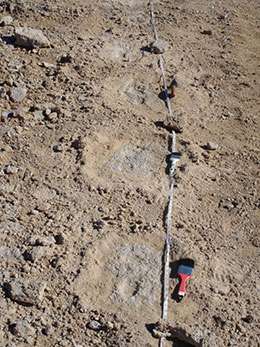Discovery of oldest footprints gives clues to Mexico's climate

The oldest human footprints in North America have been dated for the first time and could help scientists to understand what Mexico's climate was like 7000 years ago.
The new climate data, published in the Journal of Archaeological Science, comes from two sets of footprints found in the Chihuahuan desert in north-eastern Mexico.
The first of these sets was discovered in 1961 after workmen stumbled across them while building a road. At the time they were removed and placed in a museum where, despite being described in detail, their provenance was lost.
A team of researchers, from John Moores University in Liverpool, who were interested in where these prints came from began interviewing local people to see if they could find more. Eventually, in 2006, another track was found in a quarry.
'When we discovered these new prints, they were preserved in the same material as the ones in the museum. So we presumed it was a rediscovery of these lost footprints as opposed to a new discovery,' explains Dr Nick Felstead now of Durham University, lead researcher on the project.
To see if the two sets of prints were from the same track the teams needed to work out their age. So, they used oxygen and carbon isotopes in the surrounding material to work out when our ancestors made the prints.
'The age of the prints in the museum had been given a best-guess at being around 10 to 15,000 years old, but they had never actually been dated,' says Felstead. 'The two sets of dates came back at 10.5 thousand years and seven thousand years old, so by age alone we knew they were separate; they couldn't have been same trackways.'
At 10.5 thousand years old, the museum footprints pre-date the oldest evidence of humans previously known in the area – a 9000 year old piece of human faeces.
Having dated the two sets of footprints the scientists decided to look at what the climate was like when these humans laid down these trackways.
The prints were preserved in sediments known as travertine – a mineral that precipitates out when water percolates through limestone rocks - so the scientists knew the area must have been far wetter than it is today. The water which formed the travertine also contains minute traces of uranium, and it was this that enabled the team to date the footprints. Over time uranium decays and turns into thorium, by measuring the ratio of uranium to thorium the scientists were able to determine how old the footprints were.
'It's in the middle of the Chihuahua desert, everyone always thinks that deserts are hot, arid and hostile but these footprints show us that during the Holocene, the desert was just coming out of a period of glaciation and had only just started to dry out,' Felstead says. 'It's a window into a time when the desert was wet enough to support a much greater range of life.'
More information: Journal of Archaeological Science DOI: 10.1016/j.jas.2013.11.010
Journal information: Journal of Archaeological Science
Provided by PlanetEarth Online
This story is republished courtesy of Planet Earth online, a free, companion website to the award-winning magazine Planet Earth published and funded by the Natural Environment Research Council (NERC).




















